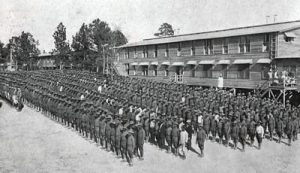New museum exhibit chronicles Fort Jackson’s 100-year history
May 8, 2017Last month our nation commemorated its entry into the First World War, so there is no better time for a new Fort Jackson exhibit at the South Carolina Confederate Relic Room and Military Museum.
Camp Jackson, as it was originally called, started training soldiers to send “Over There” in September 1917. The first units to train there were the 81st Infantry Division, which called itself the Wildcat Division, and the 371st Regiment – an African-American unit made up of South Carolinians. Each served with distinction in Europe later.
The museum’s exhibit, called “We are Going like Wild Fire Now:” The 100th Anniversary of Camp Jackson, displays artifacts and historic photographs that tell the story of how the Camp was constructed over the course of a year out of a near-wilderness area northeast of Columbia, and show the first soldiers being trained there. By war’s end, it had trained about 200,000 troops. After the Armistice was signed, most of the structures were removed and the Camp was handed over to the state of South Carolina.
In 1939, it was plain that the War to End All Wars had been anything but, so the federal government came back and began rebuilding. The Camp was renamed Fort Jackson in 1940, and continued to grow into the role it plays in our national defense, and in the life of Columbia, today.
Since then, Fort Jackson has been an ever-more-important part of the nation’s defense, training 5 million soldiers over the course of the century. Today, it is the U.S. Army’s largest basic training facility, and has a local economic impact of $2.8 billion annually.
The exhibit, which is included in general admission to the museum, will be open from now through September. Come check it out, as well as the museum’s other exhibits chronicling our state’s military history.
About the South Carolina Confederate Relic Room and Military Museum
Founded in 1896, the South Carolina Confederate Relic Room and Military Museum is an accredited museum focusing on South Carolina’s distinguished martial tradition through the Revolutionary War, Mexican War, Civil War, Spanish-American War, World War I, World War II, the War on Terror, and other American conflicts. It serves as the state’s military history museum by collecting, preserving, and exhibiting South Carolina’s military material culture from the colonial era to the present, and by providing superior educational experiences and programming. It is located at 301 Gervais St. in Columbia, sharing the Columbia Mills building with the State Museum. For more information, go to https://crr.sc.gov/.


















